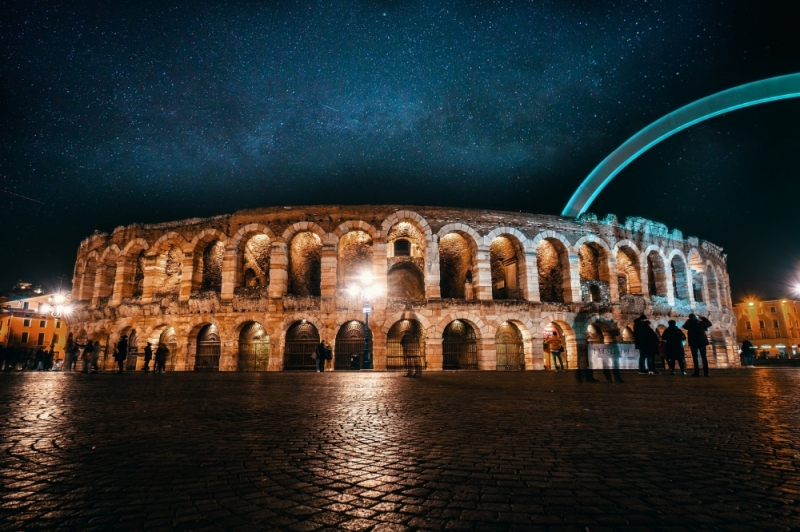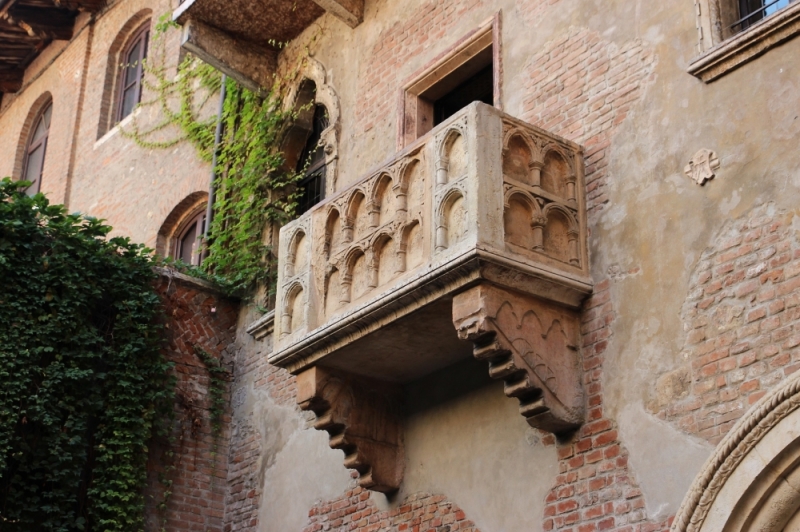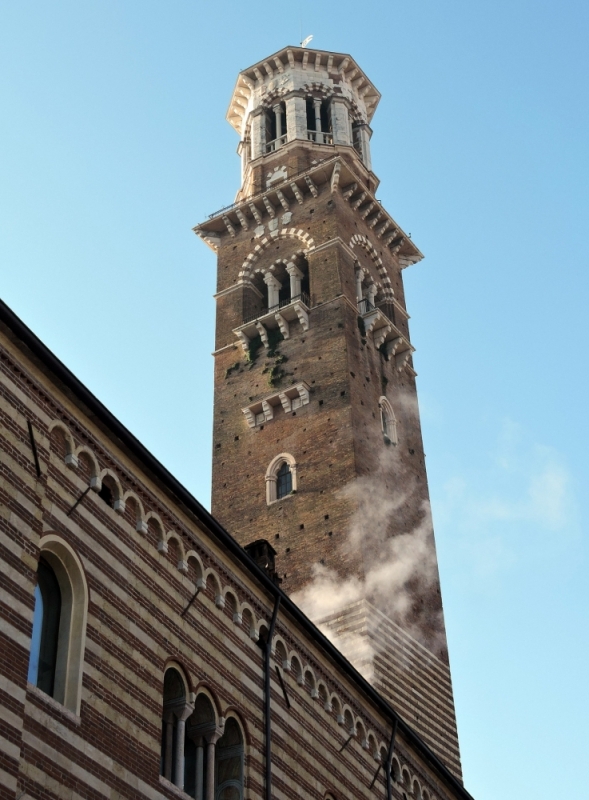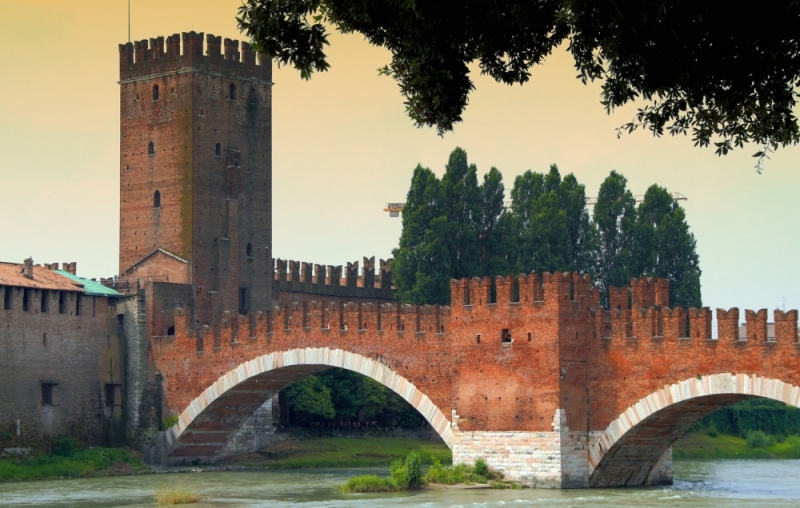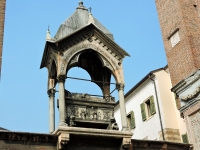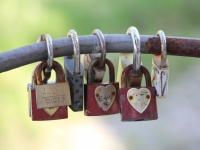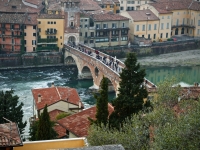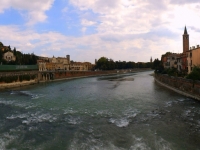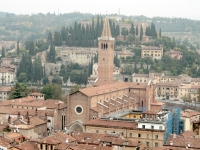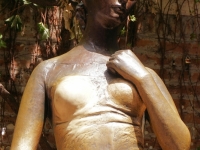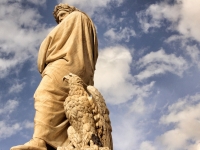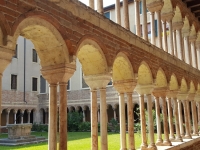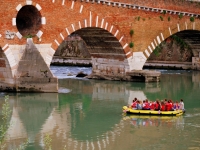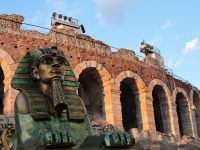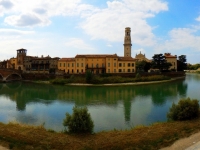Verona was originally inhabited by Reti or Euganei, but it was during the Roman domination that Verona had its ascent, becoming one of the most important cities in northern Italy, maintaining the same prestige even after the fall of the Roman Empire, when the city it became the capital of the Roman-Barbarian kingdoms. During the late Middle Ages, Verona was a free municipality and was also the site of bloody fights between the Guelphs and the Ghibellines: the first led by Sambonifacio and the latter first by the Montagues and then by the Scaligeri. Thanks to these last Verona passed from Municipality to Signoria. In 1388 Verona was first dominated by the Visconti and then by the Carraresi. During Verona's dedication to Venice in 1405, the Veronese accepted the entry of Venetian troops in order to chase away the Paduan army of Francesco II da Carrara. The Venetian troops ruled the city until 1797, the year of its fall. French and Austrian dominations alternated, until Verona was annexed to the Kingdom of Italy in 1866.
What see
Verona is known throughout the world as a city of tormented love between the two Shakespearean lovers, Romeo & Juliet.
The city, second largest in Venice, offers numerous activities to tourists: shopping, concerts, museums and much more. Its historic center has been declared a World Heritage Site by UNESCO for its incredible architecture and urban composition. Among the bridges over the Adige river and the majestic palaces, Juliet's famous balcony stands out, along with the famous Verona Arena.
Piazza Bra
As a first stop, we advise you to visit Piazza Bra (the center of which is the Arena di Verona). Girandola, you will find the Gran Guardia to the south, a majestic seventeenth-century palace, home to conferences and exhibitions, while walking towards the east of the square you can admire Palazzo Barbieri, dating back to the nineteenth century and now the seat of the Municipality of Verona. The square is full of bars and clubs, where you can sit and enjoy the city.
The Arena of Verona is the symbol of the city. It was built with Pietra Valpolicella and has some fantastic shades that go into red and pink. It was restored in the XVI century. and today it can accommodate up to 20,000 spectators, for its size is the third Roman amphitheater, after the Colosseum and the Capua Amphitheater. An unmissable event is the Opera Festival, thanks to which the Arena di Verona becomes one of the largest open-air opera houses.
Mazzini street
If you want to take a walk, Via Mazzini is the right place. Located between Piazza Bra and Piazza delle Erbe and admiring its buildings, you can also treat yourself to some shopping. Piazza delle Erbe is considered one of the most beautiful squares in Italy. It was built on an ancient Roman forum and, within it, different styles blend together. Looking around you will see the Palazzo della Ragione, the Case Mazzanti, the Palazzo Maffei and the Casa dei Mercanti. At the center of the square stands the fountain of the Madonna of Verona, dating back to the fourteenth century. There is also the famous capital from which the rulers looked out for their meetings, or even to show the heads of those condemned to death. Visiting the square you can enjoy shopping for both objects and typical culinary products. Juliet's House is located a few meters from Piazza delle Erbe. Before the courtyard you will be captured by the walls, covered with love letters and tickets written by lovers from all over the world. Looking upwards, you can admire the famous balcony where Romeo declared his love to Juliet or visit the house, which is very welcoming. You can also take a selfie with the statue of one of the most famous literature lovers.
The Lamberti tower
The Lamberti tower stands out in Piazza delle Erbe with its 84 meters high. Its construction began in the 12th century. but it was completed in the following centuries: in fact in the lower part we find tuff and bricks, while the upper one, built in the 15th century, is brick. Only later, in the eighteenth century, was the clock added. If you do not suffer from vertigo, we advise you to climb the tower and see the city from above. Near Piazza delle Erbe, you will also find the Scaliger Tombs , a Gothic-style funerary complex built for the Scaglieri family. The oldest, dating back to 1277. Porta Borsari is the gateway to the city and is found walking in the homonymous course, dating back to the first century. BC and the name refers to the soldiers, who at that time collected the duty.
Castelvecchio and the Civic Museum of Verona
Castelvecchio and the Civic Museum of Verona: the castle was built in the mid-fourteenth century. by order of Cangrande II della Scala. You will be enveloped by the medieval atmosphere. In the structure there are the large courtyard and the Royal Palace of the Scaglieri. It was once a fortress, while today it houses the Museo Civico di Castelvecchio: it will take a couple of hours to visit it, but you certainly won't regret it. The Roman Theater is located to the left of the Adige river and dates back to the 1st century BC, but today it is possible to admire only part of the original construction as part of the theater has been destroyed over time. During the nineteenth century restoration work started to recreate the old structure. If you visit Verona in the summer, know that every year in the summer there is a Festival dedicated to the theater of the great Shakespeare. The Cathedral of Verona was built in homage to Santa Maria Matricolare in 1187. The starting style was Romanesque, but the church was restored in the Gothic and Renaissance periods and the Titian Altarpiece is kept inside.
Ponte Scaligero
The Ponte Scaligero was built with the characteristic red colored bricks and from there it is possible to observe the Adige from above. It is 120 meters long and at the time it was built as an escape route. During the Second World War it was demolished by the Germans, but the remains were recovered by the Adige to rebuild the bridge. In the former convent of San Francesco al Corso it is located at the end of Via del Pontiere, inside its basement, Juliet's tomb is kept. With the same ticket, you can also visit the GB Cavalcaselle Fresco Museum . The Basilica of San Zeno was built in honor of the eighth bishop of Verona. In the central part of the facade, there is the rose window, also called the "wheel of fortune", which depicts the six phases of human life and the superficiality of material joys, which enriches the marble and tuff façade. Its interior is rich in works, including the Trittico del Mantegna, depicting the Madonna in Throne. Going up the stairs you will find the crypt in which the saint's body is kept. The Parco delle Cascate di Molina , about an hour from Verona and if you love trekking and nature, it is the right place for you. You can reach it either by bus or by car and it is a recommended destination, especially if you are traveling with children.
Movida and entertainment
If you are strolling through the center, we advise you to stop at the Osteria del Bugiardo (open every day except Monday), an informal place where you can enjoy homemade dishes such as pasta and beans, accompanied by a good glass of wine (produced by the owners of the premises), all on wooden tables in a welcoming atmosphere and at reasonable prices. For aperitif lovers, there is coffee Mazzanti, in Piazza delle Erbe, classified as one of the most beautiful in Italy. Not to be missed is the Osteria Caffè Monte Baldo, located in Via Rosa, where you can enjoy an aperitif with raw fish, canapés, croutons and glasses of wine. In a central area, between the Ponte Pietra, the Roman Theater and the church of San Giorgio in Braida, there is the Sciò Rum, where you can drink excellent cocktails. If you love fine dining, try the Caffè via Roma 33, and you will be surrounded by an elegant atmosphere. For lovers of good music there is the Cantine de l'Arena, in the historic center (near Piazza Bra), where concerts are held every Thursday and Friday from 22:30 onwards. So you will be accompanied by good music and good food, in a convivial environment. For an unparalleled musical experience, you have to attend a concert in the Arena and we assure you that you will have a unique evening. If prose, music and dance are your passion, we suggest you go to the Roman Theater, which opens every year from 25 to 29 August. Another unmissable event for jazz lovers is Verona in Jazz. But there are also events for lovers of English literature, such as the Shakespearean Festival or for fans of ballet, such as the International Dance. If you want to attend theatrical performances in a suggestive location, in the summer there is the theater event in the courtyards, where the classics of the international theater will be proposed.
If turning to Verona, you became hungry, there are so many trattorias worth trying, such as the Trattoria Stella, the trattoria Giulietta e Romeo, the trattoria Al Duomo, the Carro Armato and the Sottoriva. You will be offered traditional dishes at reasonable prices and in a characteristic environment. For wine tasters there are also interesting wine bars, such as 07 or Enoteca Cangrande.
After having dined in a trattoria and tasting a good glass of wine, we suggest you take a tour of the Piper, open from May, where you can also enjoy the view of the city from above. Strolling around Lake Garda, you can enjoy an aperitif at Paparazzi or kick back in the Hollywood hours.
Climate, curiosity and advice
Climate : the city has a predominantly continental climate, with high temperatures in summer and cold in winter. The humidity is high throughout the year, with the presence of mists during the winter.
Curiosity : in Verona there is a well dedicated to lovers, but not to Romeo & Juliet. It is dedicated to Corrado di San Bonifazio and Isabella Donati. According to legend, Corrado was a soldier in love with the young woman, but his feeling was probably not returned. One day the two saw each other at the well and he accused the young woman of being as cold as water from the well. She challenged him by telling him to jump to prove what he said and he, now resigned, threw himself into the well. She, in the grip of guilt, decided to follow him, drowning with him. If you love shopping, from Benetton in via Mazzini you will find on display clothes and…. Romans remains! A photo with the famous statue of the young Capulet is a must. But did you know that touching the right breast of the statue, popular legend wants, that it brings good luck in love?
Tips : If you are looking for a quiet and welcoming place, we recommend the Caffè & Parole: a place with a unique atmosphere, with books and various objects that will make you feel at home, where you can enjoy sweets and dishes of the day.


